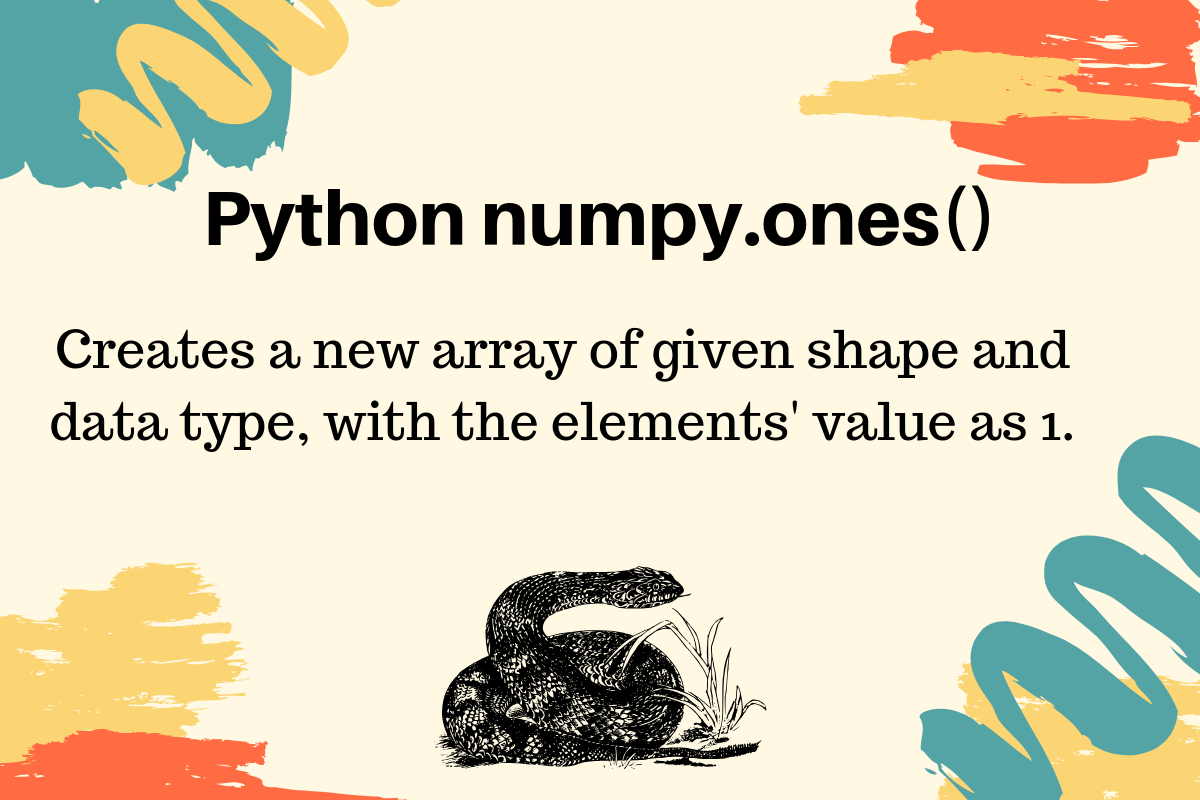- Log in to:
- Community
- DigitalOcean
- Sign up for:
- Community
- DigitalOcean

Python numpy.ones() function returns a new array of given shape and data type, where the element’s value is set to 1. This function is very similar to numpy zeros() function.
numpy.ones() function arguments
The numpy.ones() function syntax is:
ones(shape, dtype=None, order='C')
- The shape is an int or tuple of ints to define the size of the array. If we just specify an int variable, a one-dimensional array will be returned. For a tuple of ints, the array of given shape will be returned.
- The dtype is an optional parameter with default value as a float. It’s used to specify the data type of the array, for example, int.
- The order defines the whether to store multi-dimensional array in row-major (C-style) or column-major (Fortran-style) order in memory.
Python numpy.ones() Examples
Let’s look at some examples of creating arrays using the numpy ones() function.
1. Creating one-dimensional array with ones
import numpy as np
array_1d = np.ones(3)
print(array_1d)
Output:
[1. 1. 1.]
Notice that the elements are having the default data type as the float. That’s why the ones are 1. in the array.
2. Creating Multi-dimensional array
import numpy as np
array_2d = np.ones((2, 3))
print(array_2d)
Output:
[[1. 1. 1.]
[1. 1. 1.]]
3. NumPy ones array with int data type
import numpy as np
array_2d_int = np.ones((2, 3), dtype=int)
print(array_2d_int)
Output:
[[1 1 1]
[1 1 1]]
4. NumPy Array with Tuple Data Type and Ones
We can specify the array elements as a tuple and specify their data types too.
import numpy as np
array_mix_type = np.ones((2, 2), dtype=[('x', 'int'), ('y', 'float')])
print(array_mix_type)
print(array_mix_type.dtype)
Output:
[[(1, 1.) (1, 1.)]
[(1, 1.) (1, 1.)]]
[('x', '<i8'), ('y', '<f8')]

Reference: API Doc
Thanks for learning with the DigitalOcean Community. Check out our offerings for compute, storage, networking, and managed databases.
About the author
Java and Python Developer for 20+ years, Open Source Enthusiast, Founder of https://www.askpython.com/, https://www.linuxfordevices.com/, and JournalDev.com (acquired by DigitalOcean). Passionate about writing technical articles and sharing knowledge with others. Love Java, Python, Unix and related technologies. Follow my X @PankajWebDev
Still looking for an answer?
- Table of contents
- numpy.ones() function arguments
- Python numpy.ones() Examples
Deploy on DigitalOcean
Click below to sign up for DigitalOcean's virtual machines, Databases, and AIML products.
Become a contributor for community
Get paid to write technical tutorials and select a tech-focused charity to receive a matching donation.
DigitalOcean Documentation
Full documentation for every DigitalOcean product.
Resources for startups and SMBs
The Wave has everything you need to know about building a business, from raising funding to marketing your product.
Get our newsletter
Stay up to date by signing up for DigitalOcean’s Infrastructure as a Newsletter.
New accounts only. By submitting your email you agree to our Privacy Policy
The developer cloud
Scale up as you grow — whether you're running one virtual machine or ten thousand.
Get started for free
Sign up and get $200 in credit for your first 60 days with DigitalOcean.*
*This promotional offer applies to new accounts only.
